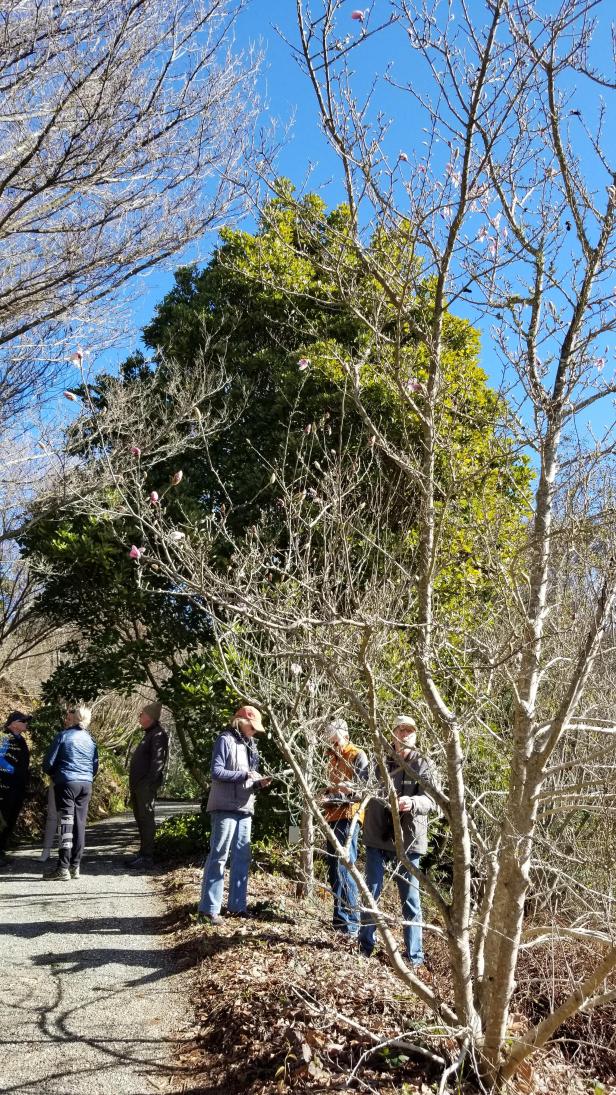 Citizen scientists take notes on the Magnolia stellata at Sonoma Botanical Garden in Glen Ellen. photo credit: Michelle Marques
Citizen scientists take notes on the Magnolia stellata at Sonoma Botanical Garden in Glen Ellen. photo credit: Michelle MarquesScience is blooming at the Sonoma Botanical Garden in Glen Ellen.
A group of volunteer citizen scientists have been meeting once a month for the past ten years to visit a particular tree called the star magnolia, or Magnolia stellata, and observe how it progresses from season to season.
Jeannie Perales is the Executive Director of Sonoma Botanical Garden, who introduces me to the group of citizen scientists…
“Good morning,” Perales said. “Hey, good morning. Hi Alison, nice to see you again. Liz, nice to see you. Cyrie and Steve of course. Great to see you guys. So this is Michelle, she's from our local NPR station. She's going to do a story on this phenology project and specifically Magnolia stellata.”
Perales is referring to the USA National Phenology Network, which monitors the influence of climate on the phenology of plants, animals, and landscapes.
Phenology studies the natural activity that happens over time in plants and animals and how that relates to seasonal changes and climates.
We head out to gather data and Perales gives us an overview of the property.
“As you pass through the Redwood Grove, you're entering the Asian Garden,” Perales said. “So this is our Asian Garden where 80-percent of the plants that you see are wild collected from temperate East Asia. They were collected on field expeditions over the course of 30 years. That's a pretty high statistic of rare, or I should say of wild genetics.”
Michael Wenzel is the Botanist and Curator of Living Collections at Sonoma Botanical Garden, and he explains how they amassed such a huge collection.
“It was primarily the former director, Bill McNamara, who was coordinating with different botanical gardens in Asia and in England and they would go out to different temperate areas of Asia primarily to collect seed,” Wenzel said.
Regulations about bringing plant material into the United States are complicated, so relationships between the original owner of Quarryhill Garden, which was the name of the garden at the time, and Kew Gardens in the UK were vitally important to get the seeds from Asia.
The group of citizen scientists head to the first of 4 trees, each of which has a branch taped off, so that they can collect consistent data, year after year.
Perales describes the magnolia as the scientists gather to examine a mostly bare tree that stands about 10 feet tall.
“This is the Star Magnolia or Magnolia stellata,” Perales said. “It's native to Central Japan, and was collected by seed there. And again, planted here. It is endangered in the wild.”
Pat Edelstein is the volunteer project organizer who has put together this team of citizen scientists, as well as others at Sonoma Botanical Garden, and she gives me a piece of paper from the National Phenology Network with a species profile of the star magnolia.
“This is something that we've done for each of the trees that we're observing,” Edelstein said. “So, these are things that we look for throughout the year. Right now we're looking for open flower buds because they come out before the leaves on this tree. So, we do it throughout the whole year."
"So, there's different markers that you're looking for at each time of year?” I asked. Edelstein answered, "Yes."
I head in to talk to the scientists as they examine the tree and talk with volunteer Steve Corey, who is gently holding a bud at the end of a branch.
“This is a flower bud,” Corey explains. “This will open and the Stellata flower will emerge from this lil’, this little bud right here.”
I asked, "Can you describe what it looks like for me?"
"Well, the Stellatas are multi-petal, 14-16 petals, typically white or pink, as I say, give it another, oh 2 weeks, a month, and it will be very spectacular." Corey said.
"Will it just be covered in blooms?" I asked.
"Pretty much, yeah," Corey responded.
I asked "And so what does this bud look like?"
"Right now, it’s all covered up," Corey explained. "As it opens though, it tends to expand. It’ll – maybe a flower about three or four inches across possibly."
"I see a tiny spot of purple in the center of it," I said to Corey. "Will the flowers be purple?"
"No, they'll be pink. White - or white or pinkish this uh, the color that you're seeing here is just as they say, it emerges," Corey answered.
The scientists are eager to show me their observations, including volunteer Liz Vaughn, who is wearing an orange-colored vest, and is making notes for the team on her clipboard.
“This is the record that we make of the various stages of the magnolia, of our four trees,” Vaughn said. “So we’re a lot of ‘Nos’ on our, on our checklist today."
Okay, so how many times are you gonna visit this tree over a year?" I asked.
"Once a month," Vaughn replied.
I asked, "How long have you guys been doing this?"
"Eight, nine, ten years. Yeah," said Vaughn.
I think about how much commitment that takes, to do something once a month, year after year, for a decade, and feel a bit ashamed about already slacking off on my new year’s resolutions, just a little over a month into the year.
But of course, this is for science, and the data wouldn’t be useful if it was only collected every now and then. Vaughn explains why they keep showing up to visit these same 4 trees.
“We're doing it for the National Phenology project so they can track trees across the country and track climate change and adaptation to climate change,” Vaughn said.
The citizen scientists work as a team even during the interview, as volunteer Cyrie Barnes steps forward to explain how the data reveals new information.
“There are a number of questions here you see we're answering about each of the trees and so they contract things like when do the leaf buds actually happen and is it changing over the years,” Barnes said. “So ten years is a good amount of time to start to notice things are changing.”
Volunteer Alison Head picks up the conversation right as Barnes finishes her sentence.
“So the data goes into a national database…so that scientists can look across the US at different sites from volunteers like us, citizen scientists as we're called,” Head said. “And, and see what the trends are across the US.”
It’s time to head to the next star magnolia tree, so we walk along graveled paths next to rushing water in a creek full from the recent rains. Barnes aligns her steps with mine.
“In the meantime, it’s just so lovely just to walk through the garden, don’t you think so?,” said Head.
“Isn't it nice? Especially after all the rain. This is great!” I exclaimed.
"I know, it's beautiful," Barnes agreed.
Barnes says there are other benefits to visiting the garden over the years, beyond scientific data collection.
“And you, actually as you spend time here, if you come back often enough and especially because we do this once a month, you get to know some of the plants pretty well,” Barnes said. “You'll walk by them and say oh look that one especially looks good now. Or oh dear that one looks like it's having a struggle.”
The second Magnolia stellata doesn’t have any blooms, but the third is starting to show off with pink and white flowers, as Alison Head shows me the way they count the blooms to determine a percentage.
“Our sample is a branch. You can see it's taped. So we're not looking at the whole tree. Although we do consider the size of the canopy in spring and summer to see how full it is,” Head explained. “Liz is looking at the branch in our sample…because it's a science project, we have to have consistency in the data collection.”
The location of the third tree also makes a difference, according to Head.
“This is a, a southern exposure,” Head said. “We're looking towards San Francisco here. So um, and it's riparian. It's near the pond."
Impressed, I responded, "Riparian, what a word!"
"It's a good word. GRE word,” Head said with a smile.
Conversations continue as we walk to the fourth and final tree in the study, and Head talks about joining the group after chatting with Edelstein.
"We have a group that needs somebody on the team." said Head. "And it was them! And you know, we've just been together ever since, looking at the trees. You know, and it's nice to get together, once a month, usually the first week. and to observe. And you know, just catch up in between.”
The final tree has some buds but has not advanced to the blossoming we saw on tree number three.
I ask Edelstein about sending their data to the US National Phenology Network, hosted by the University of Arizona, and if she has concerns about the data being deleted as political opinions on climate change shift.
“I don't think it will be eliminated, because it's a citizen science project. It's not funded by the government," Edelstein responded. "So, I don't think that would happen. They get grants to fund the project. Of course, it might be possible if it's a federal grant that they might stop it. But um no, I'm not worried that the project will stop.”
Magnolia stellata is one of 5 trees that are observed at Sonoma Botanical Garden as a part of the National Phenology Network, and each tree species is tracked by a different set of volunteers.
Perales said they will host new volunteer training in April for anyone interested.
The group of citizen scientists spend a few minutes chatting in the parking lot before settling on a date to meet next month, furthering our understanding of climate change one walk through the garden at a time.
You can see the star magnolia and more than 40 species of Asian magnolias as they begin to bloom at the Sonoma Botanical Garden in Glen Ellen this weekend, February 15 and 16 from 10:30 am to noon, and on Monday, February 17 from 1:30 to 3 PM, on a special guided stroll, along with a bonsai exhibit in honor of Valentine’s Day. Details and tickets at sonomabg.org

 Live Radio
Live Radio




